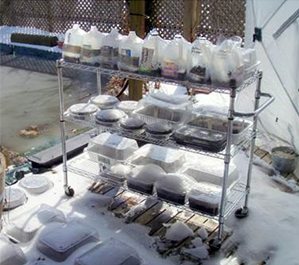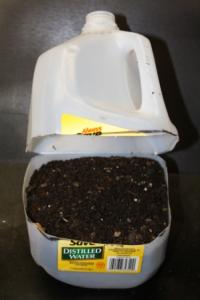Sow Your Seeds Outdoors –- in Winter!
By Marsha Goldberg, Fairfax Master Gardener
“It’s alive! It’s alive!”
 Were these the words of Dr. Frankenstein, upon hearing the beating of his monster’s heart? No, they were mine, after peering into a milk jug and discovering that tomato seedlings were sprouting inside.
Were these the words of Dr. Frankenstein, upon hearing the beating of his monster’s heart? No, they were mine, after peering into a milk jug and discovering that tomato seedlings were sprouting inside.
True, I had planted those seeds in the milk jug. But I’d done so in winter and left the jug outside in freezing temperatures and through two snowfalls; I never expected the seeds to germinate. I was just testing a “crazy” sowing technique I’d read about — a “crazy” sowing technique that worked!
Although I was skeptical, this method of winter sowing intrigued me. Could the seeds really survive freezing temperatures and excessive moisture from snowstorms? Perhaps poppies could, as those seeds like to be sown in fall and benefit from exposure to cold. And perhaps feverfew, bachelor buttons, cilantro and dill could. After all, the seeds from these plants, like some others, fall to the ground, survive winter, and happily pop up again in spring. But I had doubts about carrots and spinach, and I certainly never expected success with tomatoes and peppers — seedlings that are especially finicky about soil temperature and moisture and require the kind of close attention that newborns do.
However, I did some investigating and found that agencies including the United States Department of Agriculture have started to recognize winter sowing as a bonafide practice. So, adventuresome gardener that I am, I decided to give it a try, following the steps described on the website, Winter Sown. In January, I planted seeds for turnips, beets, tomatoes, cardinal climber vines, and poppies inside of milk jugs and put them outside. By April — without any other intervention on my part — all the seeds had sprouted except the tomato seeds. But I left the tomato jug as it was, and by May I had tiny seedlings in it as well. They were much smaller than the tomato seeds I had started conventionally indoors, but I planted them in my garden anyway, and they soon caught up. By the time the tomatoes were ready for picking, the winter-sown plants were as big and as prolific as the plants sown indoors.
My experiment showed me just how easy and practical winter sowing is. Germination rates are high, and space requirements are low. With winter sowing, you can forget positioning endless seed trays under grow lights and trying to find space on sunny windowsills for the seedlings.
If you’d like to give winter sowing a try, here are the basics:
First, decide which seeds to winter sow. Seeds that will most likely germinate successfully are those that are cold hardy and typically planted in late winter or early fall, such as greens; those that self-sow; and those that need cold temperatures to germinate. Seed catalogs and packets will give you this information, but do be bold and try a variety of seeds, including those that are less cold hardy, if you like.
 Next, choose your containers. Almost anything with a clear lid that lets the sun in can work, although you need to be able to cut slits in the top (to let in moisture and vent the heat) and in the bottom (to let water drain). Aside from milk jugs, other container options include disposable roasting pans with lids, plastic containers made to hold prewashed greens, and 2-liter soda bottles.
Next, choose your containers. Almost anything with a clear lid that lets the sun in can work, although you need to be able to cut slits in the top (to let in moisture and vent the heat) and in the bottom (to let water drain). Aside from milk jugs, other container options include disposable roasting pans with lids, plastic containers made to hold prewashed greens, and 2-liter soda bottles.
Wash out your containers carefully. If you are using a milk jug, cut about three-quarters of the way around the jug, 2 or 3 inches from the bottom. The top should be able to tilt back from the bottom but still be attached to it. Cut slits or poke holes in the bottom so water can drain out. If you are using a milk jug or soda bottle, leave the cap off to let moisture in. If using other containers, poke holes in the top as well as the bottom.
Add potting soil and moisten it; you do not have to use a seed-starting medium, although that will work as well. Follow the directions on the seed packet and sow as you normally would; that is, to the same depth and with the same spacing as if you were sowing them conventionally, and moisten lightly. Then, secure the top of the container to the bottom. If you are using a milk jug, flip the top back down and tape all around with duct tape, which will withstand the weather. If you are using a container with a separate lid, you can staple it, clip it on with alligator clips or tape it, as long as you use tape that will hold it securely in bad weather. Be sure to label the containers in a way that will last through rain or snow. I tried both an industrial strength Sharpie and a paint pen which were faded but still legible by the spring. Place the containers in a sunny spot in your garden.
That’s it! The soil should stay damp from rainfalls and snow, but check the containers to be sure. You want to see condensation inside the container. Once the weather starts to warm, after your last frost date, start to release the tops. It gets very warm inside the containers, and you don’t want your seedlings to fry. When they are large enough, transplant them to the garden as you normally would.
I learned a few things from my first experience with winter sowing that are worth sharing:
- Don’t overplant. Because I did not really think the technique would work, I sowed the seeds rather heavily in the milk jug and ended up with far too many seedlings in each. They were a tangled mess and difficult to separate. This year, I will sow fewer seeds and space them about 2 inches apart so they are easier to separate at planting time.
- Use seeds most likely to work. While the tomatoes worked surprisingly well, the best candidates for winter sowing are seeds that like the cold, such as those that need stratification or pre-chilling; seeds that typically are sown in colder weather such as greens; and seeds from plants that self-sow.
- Improvise. This year, I am going to try a variation on the whole process and use the jugs like cloches; that is, I will cut off the bottom of the jug, plant the seeds in the garden where I want them to grow, and then push the milk jug down so it covers the seeds but sits snugly in the soil. I thought about this when I was transplanting poppies, which all the literature says do not like to be transplanted. I dug a shallow hole for them, cut around the bottom of the jug until it was flat, and then slid the seedlings off until they rested on the soil. Why not, I thought, just sow them as I normally would, but cover them with the jug?
- Try different containers. There are many types that will work and might be easier to collect and store than milk jugs.
Are you ready to try winter sowing? Please go to our Facebook page and let us know the results!
References
Cool Flowers by Lisa Mason Ziegler
Master Gardeners presentation: What is Winter Sowing?, University of Illinois Extension
Winter Seed Sowing, Penn State Extension
…updated 2022